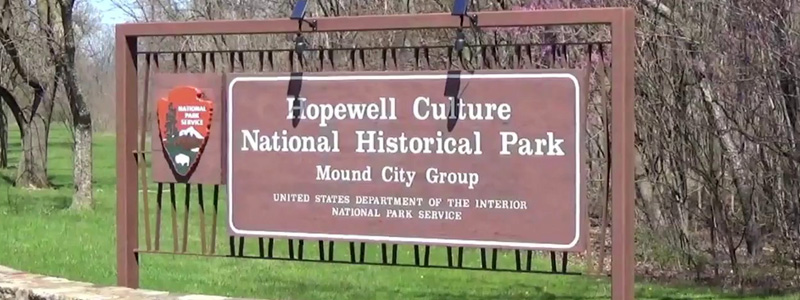Once known as Mound City, the Hopewell Culture National Historical Park features ancient earthworks and a museum highlighting these mound builders.
The Hopewell Culture National Historical Park celebrates the culture and lifestyle of these ancient Native Americans who lived throughout the Ohio River Valley region during the period from 200 BC to AD 500. The Hopewell Indians are known as “the mound builders” with good reason, as ceremonial mounds created by the Hopewell tribe dot Ohio and surrounding states.
Hopewell Culture Mound City – Native American Site
Located just north of Chillicothe on Ohio Route 104, the Hopewell Culture National Historical Park encompasses the site formerly known as Mound City, as well as other outlying units, each within a half-hour’s drive. The Mound City unit is the most photogenic of all the Hopewell Culture sites, and it includes a visitor center with a small museum and gift shop.
The History of the Mound City Group and Camp Sherman
The collection of mounds soon to be known as the Mound City Group was discovered on a farm north of Chillicothe in the middle of the 19th century. Mound City originally consisted of 23 mounds surrounded by a 3-4 foot high earthwork.
Unfortunately, Camp Sherman, a military training post used during World War One, was built on the site of Mound City, destroying many of the mounds and earthworks. After the war in 1923, President Harding established the Mound City Group National Monument restoring many of the mounds destroyed by Camp Sherman.
In 1992, the Hopewell Culture National Historical Park was created to include the Mound City Group as well as other nearby Hopewell sites, including Hopeton Earthworks, High Bank Works, Hopewell Mound Group, and Seip Earthworks.
Visiting Mound City and the Hopewell Culture National Historical Park
A visit to Mound City and the other surrounding Hopewell sites is a great way to spend a day in Southern Ohio. The museum at the Mound City Group features artifacts excavated on-site and does a fine job of illustrating the culture of the Hopewell people.
The visitor center at Mound City, open year-round except for Christmas, Thanksgiving, and New Year’s Day, includes the museum and a well-stocked gift shop. A 17-minute film explaining the Hopewell people is shown daily at the museum. There are no fees at the visitor center, but donations are appreciated.
Self-guided interpretive trails are located at Mound City, with others currently being built at some of the other sites, including the Hopewell Mound Group and Seip Earthworks. Mound City is the highlight of the entire park.
The Hopewell Culture National Historical Park is a must-visit for fans of ancient Indian culture. It is perfect for a day trip when staying at nearby Deer Creek Resort and Conference Center, and it is also close to the photogenic Scioto Trail State Park.

